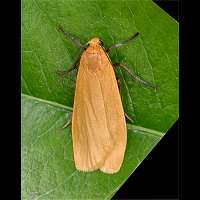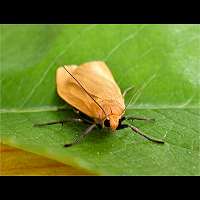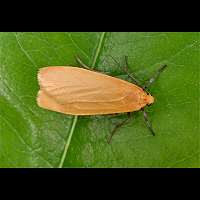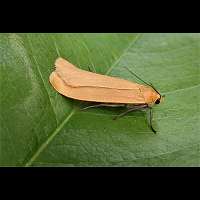Orange Footman (Eilema sororcula)
The Orange Footman is a striking species and can be identified easily: an all yellowish orange Footman. Another characteristic is that it is the first footman on the wing in spring time. Only a worn out and relatively late flying individual could present one with a problem. However the shape of the wing is another good thing about the Orange Footman. The edge of the front wing is strongly curved towards the tip of the wing and the tip itself is very blunt compared to other Footmen. The wingspan of some 18 to 22 mm makes this a rather small species.
The eggs are being laid by the end of spring and hatch from the end of June onwards. The larvae are active to the end of September. Than they produce a very flimsy cocoon, which is attached to lyches. In the cocoon the caterpillar pupates and as such overwinters. The first moths appear in April of the next year. The larvae of the Orange Footman do look like the caterpillars of other footman: black creatures with greyish hairs and a yellowish white dorsal line. Luckily they are easily identified by the white bar on the back, just behind the middle (on the 11th segment). The caterpillars will reach a length of some 18 to 22 mm. The caterpillars exclusively live on lyches on old trees and shrubs, such as birk, beech, oak and hawthorn.
The adult is on the wing in June mainly. Flies by night exclusively. The moths usually stay in the vicinity of the tree they grew up in, which is an old, lyches-clad tree. They can be attracted by light, but will not fly far from the tree. A trap under such an old tree however can produce a great number of Orange Footmen. Rests on leaves or branches during the day and remains seated once discovered. It thus is a very good photographer's model. A common, but extremely local species in southern parts of England and Wales. Does not live in Northern Europe. Is a common, but local species on the continent as well.
The Orange Footman is a striking species and can be identified easily: an all yellowish orange Footman. Another characteristic is that it is the first footman on the wing in spring time. Only a worn out and relatively late flying individual could present one with a problem. However the shape of the wing is another good thing about the Orange Footman. The edge of the front wing is strongly curved towards the tip of the wing and the tip itself is very blunt compared to other Footmen. The wingspan of some 18 to 22 mm makes this a rather small species.
The eggs are being laid by the end of spring and hatch from the end of June onwards. The larvae are active to the end of September. Than they produce a very flimsy cocoon, which is attached to lyches. In the cocoon the caterpillar pupates and as such overwinters. The first moths appear in April of the next year. The larvae of the Orange Footman do look like the caterpillars of other footman: black creatures with greyish hairs and a yellowish white dorsal line. Luckily they are easily identified by the white bar on the back, just behind the middle (on the 11th segment). The caterpillars will reach a length of some 18 to 22 mm. The caterpillars exclusively live on lyches on old trees and shrubs, such as birk, beech, oak and hawthorn.
The adult is on the wing in June mainly. Flies by night exclusively. The moths usually stay in the vicinity of the tree they grew up in, which is an old, lyches-clad tree. They can be attracted by light, but will not fly far from the tree. A trap under such an old tree however can produce a great number of Orange Footmen. Rests on leaves or branches during the day and remains seated once discovered. It thus is a very good photographer's model. A common, but extremely local species in southern parts of England and Wales. Does not live in Northern Europe. Is a common, but local species on the continent as well.







